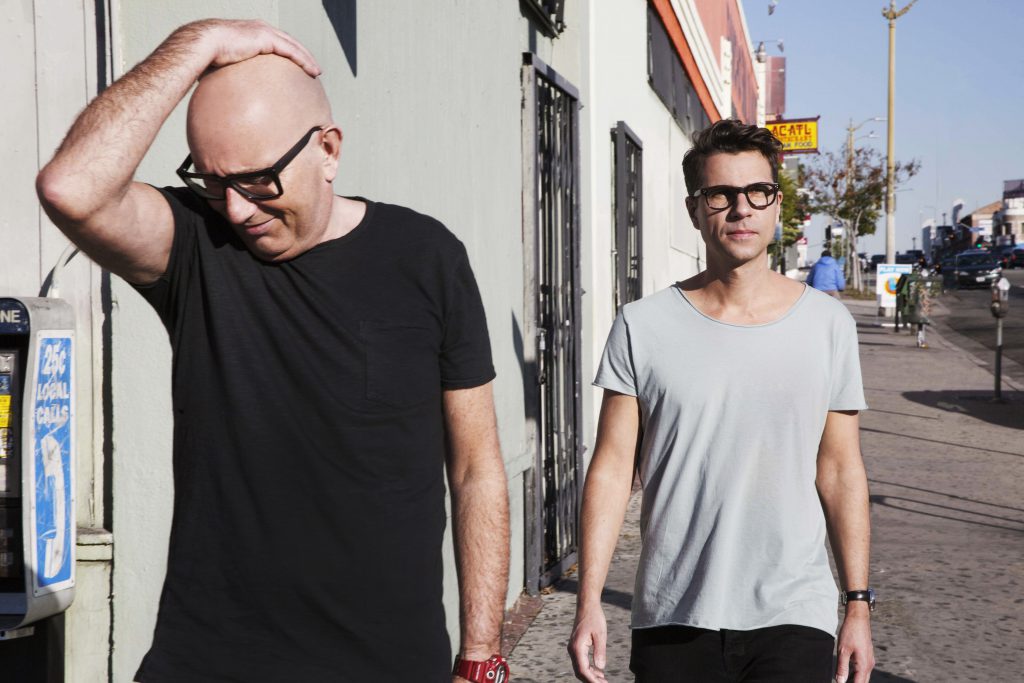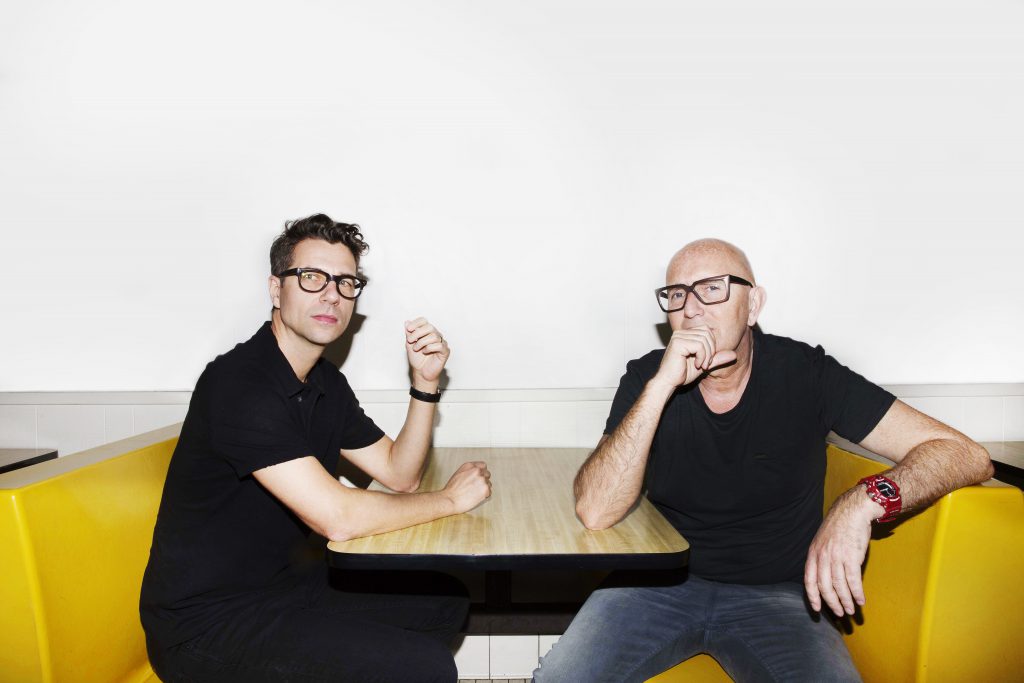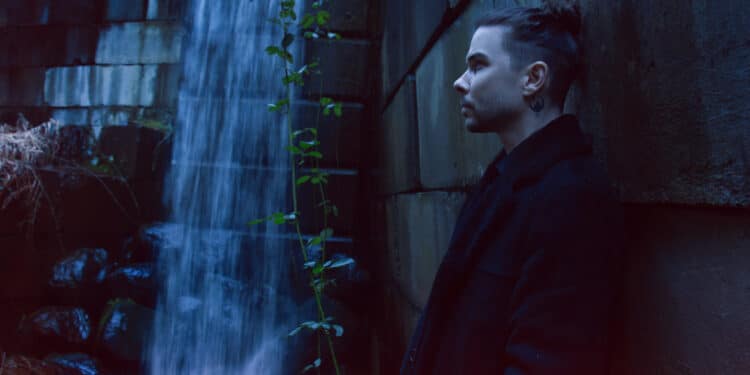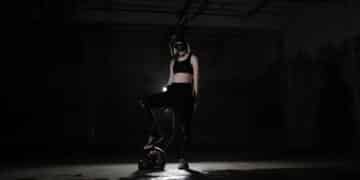Over the years they’ve been known by many aliases, The Good Men, Zki & Dobre, or most recently Chocolate Puma.
Gaston Steenskist and René ter Horst have produced music for the better part of two decades now. Laidback Luke calls them “The Godfathers of House” and they say it’s because they’re so old. I wouldn’t call them old, but they’ve been in the scene before I was even born…so they know a thing or two when it comes to production and putting on a show. They’ve played at a variety of festivals around the world and they’ve collaborated with huge names in the industry like Laidback Luke, Sander van Doorn, Oliver Heldens, Firebeatz, and Bingo Players. Their quintessential house music and their beats always keep the dance floor moving all night long and when I caught both their sets on Groove Cruise Cabo 2016, I was blown away by their record selection as well as their mixing talent, and incredible prowess behind the decks. Read on as we talk music production, collaborations, and travelling with Chocolate Puma!
Missed our Groove Cruise Cabo 2016 coverage? Read our comprehensive Event Review by clicking here!
Stream Chocolate Puma’s Classic Set from Groove Cruise Cabo 2016:
Can you describe what dance music means to you?
Gaston: It means everything. That’s a difficult one. It means everything, our whole life has changed because of dance music. When we heard the first house records back in the eighties, we thought like “Holy shit this is so cool, we want to hear this for the rest of our lives.” And even better if we could make it. So in that way it means a lot, it changed the whole course of our lives.
You’ve been in the industry for over 25 years now, what are some of the differences or changes you’ve seen occur from then to now?
René: Well, the biggest change is that it’s now all mainstream. When we first started it was really small and underground. Everybody was wondering what is this monotone music and where is it coming from. So that’s one of those changes, at that time we all said that the records we heard then “The whole world must hear these records.” And now it’s happening. Everybody, all the pop music is based on house music now, four to the floor and EDM. So that’s a big change and of course equipment-wise with producing, we used to have all this hardware connected with cables and a MIDI and a big mixing desk. Now we have the whole studio in a laptop so everywhere we go we can make music so that’s also a big change. Before we had to travel the world with all our vinyl, in very heavy cases and now we’re traveling one USB stick. More people recognize it and it’s easier now, you have more time to be creative.
You’ve both have either been in or been a part of numerous DJ or musical groups over the years. How has each of those projects influenced the sound you have now?
G: We used to have all these projects, it was the way it was in the nineties. With every project we had another sound but then we decided ten years ago, “Ok maybe we should only focus on Chocolate Puma.” And we incorporated all the sounds we used to do for different projects into Chocolate Puma. We used to do Jark Prongo for more techno kind of stuff. But we also do it now under Chocolate Puma because we believe we should have one brand and we can do whatever we like musically. So if we’re in the studio maybe we say “Ok it should sound like a Jark Prongo record.” Or something we used to do as this project or that project, but now we just put it under the Chocolate Puma umbrella. We can have one brand that does everything. Especially now that your brand is more important than it used to be. Even if only for the simple fact that people want to Google you. If you have ten different names, it’s confusing and easy for them to lose track. Also the difference with how it used to be, now people accept it more that you do different styles on one project, back in the day you needed all of these projects to have different sounds. We also used to release vinyl, and we’d have three records and they’d all be in the record shop. Now it’s totally different, you have streaming and downloading, you need one brand.
Over the years you’ve no doubt learned quite a few lessons not only about the music industry but also about life. What’s the number one piece of advice you think more people should know?
G: I think the most important lesson is that you have to surround yourself with people you trust. People you can connect with. So that you can work together on your career and on your projects.
R: You can’t do it alone. You need good management and a good record label, and etcetera.
G: And I think over the years we got rid of the noise. A lot of people that didn’t contribute to what we thought was good. So yeah we have a very small team. We have our manager and our bookers, and that’s it.
Since you have been in the industry so long, you’ve DJ’d a multitude of different styles and genres from Acid House to Techno to Deep House and everything in between. Do you have a favorite style or genre to play that you wish you could play more of?
R: We play all styles. Ok maybe not all, we don’t play Hardstyle or something like that. But in the house genre, we play Deep, and Techno, and everything we like. That’s the way we like it. We find it boring to play a whole techno set or a whole deep house set. That’s why we play all the tracks together. And that’s I think, our style, and that’s what we love to play, and that’s what we do.
It’s been noted that your studio setup may be more simplistic than others and that you’ve said some producers focus solely on the sound quality or effects but forget that a track still has to be musically interesting. What are some of the ways you make a track musically interesting?
G: Wow that’s a good question. If you start making something and it gets you excited like “Wow this is really cool.” Or “Wow I really like this.” That’s the number one thing that has to happen. Otherwise, you’re polishing a turd. If you have something that sucks but it sounds amazing, what’s the use? First, we focus on the right idea, maybe the right melody, the right sample, or there’s a really cool sound for bass that we play around with. The idea is the most important thing. The mix, the mastering, all that kind of stuff, you can fix it. And if you’re not the best in mixing, maybe you can ask a friend to mix it or hire somebody to do it. But if you have the right idea, that’s the most important and I think the hardest thing. If you have that then you can move on to whatever.
You just released the track “Steam Train” with HI-LO in August, and you had worked with Oliver Heldens on a collaboration previously. What was it like working with him on that track, and did the production process differ working on a HI-LO track versus an Oliver track?
R: First of all it’s really fun to be with Oliver in the studio. We’re good friends with him. So we have a good time.
G: He’s the craziest guy.
R: I think the biggest difference between with Oliver as Oliver, or as HI-LO is the music. HI-LO is his more underground/techno kind of thing. So that’s the biggest difference. But he’s the same person. He’s put on a lot of masks and suits and stuff, but in the studio, he’s not putting on a HI-LO mask, he’s still Oliver.
You guys have made too many tracks to count almost, some that have charted, some that have been number one hits, and some that haven’t quite made it. Have you learned more from the tracks that became hits or the ones that haven’t?
G: What you learn from the tracks that aren’t hits is there isn’t a lot of bullshit going on after that. So you know you have to deal with all kinds of stuff that comes with a hit. We love to be in the studio, we love to DJ. We also like to do all the other stuff.
R: I think sometimes you make a record and we think… “Well, this is so great, it’s going to be huge on the radio as well, this is going to be a hit record.” And we’re all excited and then it gets released and yes people like it, but it’s not a hit record. And then another record you make you also like, but you said to each other “It’s a nice record, it’s a good tool to DJ, but it’s not going to be a hit record.” And that will end up being the hit record. So we never sit down to make a hit record, we make music. So I think the biggest thing you learn is if you go really underground it will never be a hit. But if you go sit down and say “Let’s make a #1 hit.” Most of the time it will be a good record but not a #1 hit.
G: But also like with “Scrub The Ground”, it was a huge dance record. Everybody was playing it. But also playing it for so long. Like during the year, everybody was still playing it. That was a record that was almost an accident. We made the sound and within minutes there was the track. You can never know beforehand if you make something like that. It comes from where ever, and there’s the track. So what you can learn from that is that you shouldn’t think too much about what to do. Just let it happen and there it is.
How do you decide on which tracks are put in the “Throwing Some Tunes Together” Mixes that you have released?
G: It’s just tracks we like. What we’re listening to. We get promos, we go on Soundcloud and Beatport. And we’re like “These are cool records.” Some of the records end up in our DJ sets, some of the records we just like, not necessarily something for our sets maybe. It’s essentially a random collection of cool tracks and things we’re listening to at the time.
Having been DJing for decades, you’ve traveled and play shows all over the world. What is your favorite country or countries you’ve been to and why?
R: The United States we’re a big fan of because they are really going for our music. Also when we do a big festival, like we did EDC [Orlando], and if there’s a big EDM DJ before us, and we come after, they switch in their head and say “Ok we had one hour EDM, now it’s Chocolate Puma time so let’s dance.” That’s one of the favorite countries. And Asia, Tokyo is also nice. Canada is also doing insane. It’s too much. Every country has its own clubs or festivals. Especially Europe, they’re a little bit behind. Just a little bit right now.
G: With the US and Canada, what we noticed the two countries have in common is people go out. You also see it on Groove Cruise. They’ve already decided it’s going to great. So with that mindset, they’re coming to the festival or the club and they’re like “Yeah! Let’s do it!” Whereas in Europe it’s sometimes more difficult because people go to a club and they let it depend on what the DJ is doing. So they’re like “Ok, show me first, and maybe then I’ll have a good time.” Which is fine because it means we really have to work hard to convince them. And if we convince them its super cool. But there’s a slight difference in mindset going on in the US and Canada, in that perspective.
So would you say in the US and Canada they go more for the experience and in Europe, they go more for the music?
G: Not necessarily. They still go for the music but they’re ready and they say “Let’s bring it on, and let’s go.” More of that attitude. And that’s something that we sometimes miss in our country The Netherlands. Some people say that the crowd in The Netherlands is hard to get. But once you get them, they’re quite good.
What’s the hardest part about traveling and what things do you do to ease the stress that is caused by traveling so much?
R: Flying through time zones and most of the time it happens on the weekends. Long weekends but still weekends. So you sleep, or you sleep two hours and you have the next flight. And that’s eating your energy. The thing you need is energy if you have to play a set. So we try to, if we see a bed when we travel, it doesn’t matter what time it is because we’re mostly in a different timezone. And it’s daytime or night when we have breakfast or whatever. So when we see a bed we go to sleep. And if there’s any healthy food around we try to eat that. Most of the time we do tours in the US or Canada for 12 or 15 days maximum. And then we try to go back to Europe and do some studio time and rest. Travelling is hard. You can be so tired, but if you get back in the DJ booth and you get that energy from the crowd, you can handle it big time.
Well, that’s all the questions we had for you guys, we appreciate you taking the time out to talk with us.
G&R: Not a problem, thank you!
Connect with Chocolate Puma on Social Media:
Website | Facebook | Twitter | Instagram | SoundCloud









